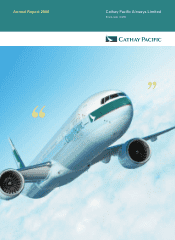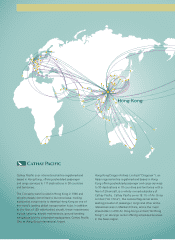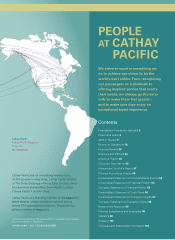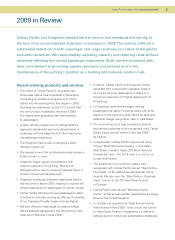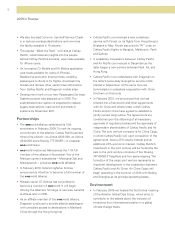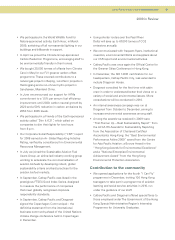Cathay Pacific 2009 Annual Report Download - page 5
Download and view the complete annual report
Please find page 5 of the 2009 Cathay Pacific annual report below. You can navigate through the pages in the report by either clicking on the pages listed below, or by using the keyword search tool below to find specific information within the annual report.
Chairman’s Letter
The main story of 2009 was the impact on our
business of one of the most severe economic
downturns in recent memory. The global slump
resulted in extremely challenging business conditions
for the Cathay Pacific Group and commercial aviation in
general. While there was some pick-up in both our
passenger and cargo businesses towards the end of
the year as the recession began to ease, overall we
saw a deep downturn in our key markets which in turn
led to sharply reduced revenues.
We took a number of measures to help us address
the steep downturn in business, including reducing
capacity in both Cathay Pacific and Dragonair, reducing
operating costs and capital expenditure, introducing an
unpaid leave scheme for staff, parking a number of
aircraft, working to get concessions from suppliers
and requesting a deferral of new deliveries from
aircraft manufacturers.
Fuel prices in the first half of the year were significantly
lower than the record highs of mid-2008. However,
they started to rise again in the middle of 2009,
reaching uncomfortably high levels. This rise was
reflected in mark to market gains of HK$2,018 million
recorded in 2009 in respect of fuel hedging contracts
for the period 2010-2011. These gains reversed a large
part of the substantial losses recorded in 2008 in
respect of fuel hedging contracts. We expect the
results of fuel hedging to be less volatile in future.
Cathay Pacific and Dragonair between them carried
24.6 million passengers in 2009 – a fall of 1.6% on the
previous year. Our capacity fell by 3.7% compared to
2008 as we reduced frequencies and (in the case of
Dragonair) temporarily suspended operations to six
destinations. This in turn supported the load factor,
which at 80.5% rose by 1.7 percentage points
The Cathay Pacific Group recorded an attributable profit of HK$4,694 million for
2009. This compares to a loss of HK$8,696 million the previous year. Turnover for
the year fell by 22.6% to HK$66,978 million. Earnings per share rose by HK340.3
cents to HK119.3 cents.
compared to 2008. Our passenger revenue fell by
20.8% to HK$45,920 million, reflecting substantial
reductions in premium traffic and in economy class
yields, though economy class passenger numbers held
up well. The strong US dollar in the first half of the year
also contributed to the 19.5% fall in passenger yield for
the year.
Cargo revenue for the Cathay Pacific Group fell by
29.9% to HK$17,255 million in 2009, while the amount
of freight carried for Cathay Pacific and Dragonair
dropped by 7.1% to 1,527,948 tonnes. We reduced
cargo capacity by 13.1% in response to the weakness
in demand. This was reflected in a load factor of 70.8%
(compared with 65.9% in 2008). Our cargo business
was exceptionally weak in the first half of the year,
with a significant decline in tonnage and yield in all key
markets. The latter half of the year was stronger with
yield increasing in October, albeit from a very low
base, and rising consistently for the remainder of
the year. Our cargo yield for the year fell by 26.8%
to HK$1.86.
Despite 2009 being a very difficult year for the
Cathay Pacific Group, we worked hard to keep the
fundamentals of our business intact. Though we cut
capacity and parked a number of passenger and cargo
aircraft, we have kept our network substantially intact.
We also went to great efforts to ensure that the quality
of our product and service was not diminished and that
the passenger experience was not compromised. We
continued with the rollout of our innovative three-class
cabin designs for our medium- and long-haul fleet, with
all aircraft fitted with the cabins by November. New
aircraft continued to arrive, improving the overall
efficiency of our fleets, while the remaining older, fuel-
inefficient Boeing 747-200F “Classics” were retired.
Cathay Pacific Airways Limited Annual Report 2009 3

